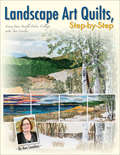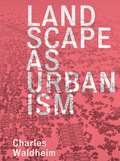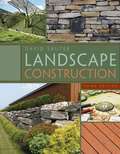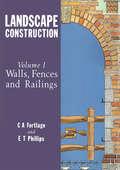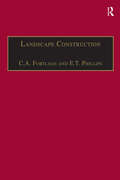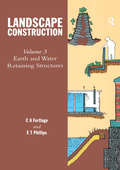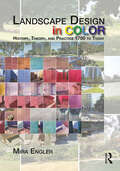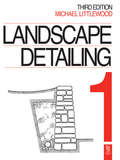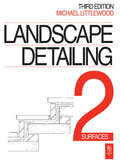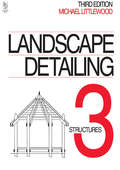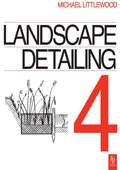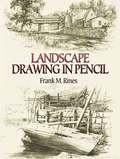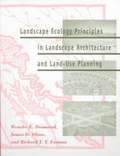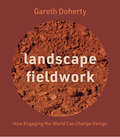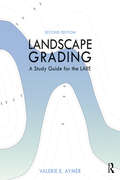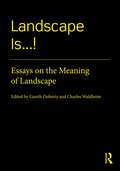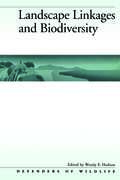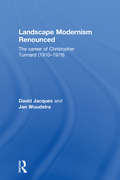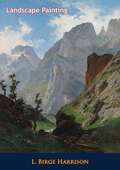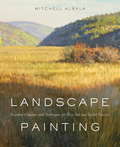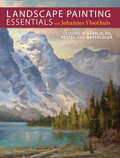- Table View
- List View
Landscape Architecture: An Introduction
by Robert Holden Jamie LiversedgeAimed at prospective and new students, this book gives a comprehensive introduction to the nature and practice of landscape architecture, the professional skills required and the latest developments.After discussing the history of the profession, the book explains the design process through principles such as hierarchy, human scale, unity, harmony, asymmetry, colour, form and texture. It looks at how design is represented through both drawing and modelling, and through digital techniques such as CAD and the use of GIS (Geographic Information Systems). This is followed by an examination of project management and landscape management techniques. Finally, the book explores educational and employment opportunities and the future of the profession in the context of climate change and sustainability.Illustrated with international examples of completed projects, Landscape Architecture provides an invaluable, one-stop resource for anyone considering studying or a career in this field.
Landscape Architecture: An Introduction
by Robert HoldenAimed at prospective and new students, this book gives a comprehensive introduction to the nature and practice of landscape architecture, the professional skills required and the latest developments.After discussing the history of the profession, the book explains the design process through principles such as hierarchy, human scale, unity, harmony, asymmetry, colour, form and texture. It looks at how design is represented through both drawing and modelling, and through digital techniques such as CAD and the use of GIS (Geographic Information Systems). This is followed by an examination of project management and landscape management techniques. Finally, the book explores educational and employment opportunities and the future of the profession in the context of climate change and sustainability.Illustrated with international examples of completed projects, Landscape Architecture provides an invaluable, one-stop resource for anyone considering studying or a career in this field.
Landscape Art Quilts, Step-by-Step: Learn Fast, Fusible Fabric Collage with Ann Loveless
by Ann LovelessThe award-winning art quilter shares her free-form technique for capturing the beauty of nature using collage and fusible web in this step-by-step guide.Two-time ArtPrize-winner Ann Loveless is known for creating stunning landscape quilts depicting the beautiful natural landscapes of her Lake Michigan home. In Landscape Art Quilts, Step-by-Step, she reveals the creative and technical processes behind some of her best-known designs.With step-by-step instructions, Ann demonstrates her free-form method of cutting and placing fabrics on fusible web and finishing with free-motion machine quilting. By learning Ann’s original techniques, you will be able to create your own art quilts based on your favorite landscape photographs.
Landscape As Urbanism: A General Theory
by Charles WaldheimIt has become conventional to think of urbanism and landscape as opposing one another--or to think of landscape as merely providing temporary relief from urban life as shaped by buildings and infrastructure. <P><P>But, driven in part by environmental concerns, landscape has recently emerged as a model and medium for the city, with some theorists arguing that landscape architects are the urbanists of our age.
Landscape Construction
by David SauterLandscape Construction, 3rd edition, will help your students understand the process of construction and implementation of a multitude of exterior hardscape construction projects. This book begins with the preparation for construction and follows through to the installation of the final elements of the landscape project. Your students will appreciate the detailed discussions about site preparation, grading and drainage, utilities and irrigation, retaining wall construction, paving, exterior carpentry and fencing and free-standing walls. Such amenities as pools, ponds, and edging are also discussed in detail. All instructions are well supported by photos and illustrations. Each section contains thorough installation information for most of the contemporary materials used in today's landscapes. David Sauter has provided your students with expert perspective on materials and techniques, as well as easy-to-follow instructions.
Landscape Construction: Volume 1: Walls, Fences and Railings
by C. A. Fortlage E. T. PhillipsLandscape Construction Volume 1 deals with elements of landscape construction which are required to provide enclosure, privacy, demarcation of land, shelter and security. The elements discussed include free-standing brick and stone walls, fences, gates and railings. Fittings and finishes are also covered. Each section describes the materials, construction and constraints relevant to the subject and a large number of detailed figures and photographs supplement the text and help to illustrate the more important aspects. There is also a section on preservation treatment and painting. The current British Standard references are included.
Landscape Construction: Volume 2: Roads, Paving and Drainage
by E.T. Phillips C.A. FortlageLandscape Construction Volume 1 deals with elements of landscape construction which are required to provide enclosure, privacy, demarcation of land, shelter and security. The elements discussed include free-standing brick and stone walls, fences, gates and railings. Fittings and finishes are also covered. Each section describes the materials, construction and constraints relevant to the subject and a large number of detailed figures and photographs supplement the text and help to illustrate the more important aspects. There is also a section on preservation treatment and painting. The current British Standard references are included.
Landscape Construction: Volume 3: Earth and Water Retaining Structures
by E.T. PhillipsLandscape Construction Volume 1 deals with elements of landscape construction which are required to provide enclosure, privacy, demarcation of land, shelter and security. The elements discussed include free-standing brick and stone walls, fences, gates and railings. Fittings and finishes are also covered. Each section describes the materials, construction and constraints relevant to the subject and a large number of detailed figures and photographs supplement the text and help to illustrate the more important aspects. There is also a section on preservation treatment and painting. The current British Standard references are included.
Landscape Design in Color: History, Theory, and Practice 1750 to Today
by Mira EnglerArchitects, landscape architects and urban designers experiment with color and lighting effects in their daily professional practice. Over the past decade, there has been a reinvigorated discussion on color within architectural and cultural studies. Yet, scholarly enquiry within landscape architecture has been minimal despite its important role in landscape design. This book posits that though color and lighting effects appear natural, fleeting, and difficult to comprehend, the sensory palette of built landscapes and gardens has been carefully constructed to shape our experience and evoke meaning and place character. Landscape Design in Color: History, Theory, and Practice 1750 to Today is an inquiry into the themes, theories, and debates on color and its impact on practice in Western landscape architecture over the past three centuries. Divided into three key periods, each chapter in the book looks at the use of color in the written and built work of key prominent designers. The book investigates thematic juxtapositions such as: natural and artificial; color and line; design and draftsmanship; sensation and concept; imitation and translation; deception and display; and decoration and structure, and how these have appeared, faded, disappeared, and reappeared throughout the ages. Richly designed and illustrated in full color throughout, including color palettes, this book is a must-have resource for students, scholars, and design professionals in landscape architecture and its allied disciplines.
Landscape Design, Construction, and Maintenance
by Charles B. Schroeder Ronald J. BiondoNIMAC-sourced textbook
Landscape Detailing Volume 1: Enclosures
by Michael LittlewoodMichael Littlewood's Landscape Detailing is now well established as a valuable source of reference for architects, landscape architects, other professionals and students designing external works.Volume I, Enclosures, covers walls (free-standing, screen and retaining), fences, gates, barriers and bollards. Each section begins with technical guidance notes on design and construction and then provides a list of points against which specifications can be checked. This is followed by a set of drawn-to-scale detail sheets. These details can be traced for direct incorporation into the set of contract drawings. A list of relevant British Standards, references, bibliography and a list of associations and institutions indicate where further guidance can be obtained. As a ready reference for landscape designers and as an indispensable time-saving tool, Landscape Detailing is an essential for the design office.
Landscape Detailing Volume 2: Surfaces
by Michael LittlewoodAs a ready reference for landscape designers and as an indispensable time-saving tool, Landscape Detailing is an essential for the design office.Each section begins with technical guidance notes on design and construction and then provides a list of points against which specifications can be checked. This is followed by a set of drawn-to-scale details sheets. These details can be traced for direct incorporation into the set of contract drawings. A list of relevant British Standards, references, bibliography and a list of associations and institutions indicate where further guidance can be obtained.
Landscape Detailing Volume 3: Enclosures
by Michael LittlewoodMichael Littlewood's Landscape Detailing is now well established as a valuable source of reference for architects, landscape architects, other professionals and students designing external works. For this third edition it has been split into three volumes to give a greater depth of coverage than ever before.Volume 3 covers pergolas, arbours, arches, gazebos, summer houses, sheds, shelters, decks, footbridges, furniture and roofs. Each section begins with technical guidance notes on design and construction. This is followed by a set of drawn-to-scale detail sheets. These details can be traced for direct incorporation into the set of contract drawings. A list of relevant references, bibliography and a list of association and institutions indicate where further guidance can be obtained. A ready reference for landscape designers and an indispensable time-saving tool, Landscape Detailing is an essential for the design office.
Landscape Detailing Volume 4: Enclosures
by Michael LittlewoodWell established as a valuable source of reference for architects, landscape architects, professionals and students designin external works. This volume covers water features and offers drawings detailed to scale, unlike many of the other books on the market which only deal in sketch forms.Covers landscape ponds, streams and waterfalls, fountains, edges, bank protection, revetments, dams, weirs and sluices, island rafts and jetties and drainage. Each section begins with technical guidance notes on design and construction. This is followed by a set of drawn-to-scale detail sheets. These details can be traced for direct incorporation into the set of contract drawings. A ready reference for landscape designers and an indispensable time-saving tool, Landscape Detailing is an essential for the design office.
Landscape Drawing in Pencil (Dover Art Instruction Ser.)
by Frank M. RinesConcise and beautifully illustrated, this guide provides invaluable instruction on the art of pencil drawing. It covers the basics of holding the pencil, applying different strokes, shading, perspective, and the rendering of different textures, as well as the finer points of pictorial composition and drawing from nature.Based on the author's years of experience teaching art students at all levels, this book is ideal for home or class use. Its thirty-six evocative sketches range from English castles to American bridges, with a few detailed close-ups showing how to surmount some of the problems of depicting rocks, roofs, standing water, or leafy tree branches. The accompanying text describes how artists at every level of experience can develop their own pencil technique by employing fundamental rules.
Landscape Ecology Principles in Landscape Architecture and Land-Use Planning
by Richard T. T. Forman Thomas C. Brown David M. Gillilan Wenche E. Dramstad James D. Olson Richard T. Forman Harvard University Graduate School of Design Staff Wenche DramstadLandscape ecology has emerged in the past decade as an important and useful tool for land-use planners and landscape architects. While professionals and scholars have begun to incorporate aspects of this new field into their work, there remains a need for a summary of key principles and how they might be applied in design and planning. This volume fills that need. It is a concise handbook that lists and illustrates key principles in the field, presenting specific examples of how the principles can be applied in a range of scales and diverse types of landscapes around the world. Chapters cover: patches -- size, number, and location edges and boundaries corridors and connectivity mosaics summaries of case studies from around the world
Landscape Fieldwork: How Engaging the World Can Change Design
by Gareth DohertyRefocusing on human inhabitants in landscape architecture Landscape architecture is at a crossroads. The ability to draw upon interdisciplinary perspectives and generate insights from the combined vantage points of design, environmental studies, and the social sciences puts it in a prime position to address the most pressing issues of our time, such as climate change and social inequality. Its current reliance on digital and technological solutions, however, has increasingly caused landscape architects to lose sight of the ways in which humans actually use spaces. And while landscapes are designed all over the world, the discipline remains inordinately centered on the Global North. Landscape Fieldwork alters that long-standing paradigm through real-life examples that provide tools for practitioners to engage more deeply with multidimensional, diverse landscapes and the communities that create, live in, and use them.
Landscape Grading: A Study Guide for the LARE
by Valerie E. AymerFor every element that we design in the landscape, there is a corresponding grading concept, and how these concepts are drawn together is what creates a site grading plan. This study guide explores these concepts in detail to help you learn how to grade with confidence in preparation for the Grading, Drainage and Construction Documentation section of the Landscape Architecture Registration Examination (LARE). This updated second edition is designed as a textbook for the landscape architecture student, a study guide for the professional studying for the LARE, and a refresher for licensed landscape architects. New to this edition: • Additional illustrations and explanations for grading plane surfaces and warped planes, swales, berms, retention ponds, and drain inlets; • Additional illustrations and explanations for grading paths, ramp landings, ramp/stair combinations and retaining walls; • A section on landscape and built element combinations, highlighting grading techniques for parking lots, culverts and sloping berms; • A section on landscape grading standards, recognizing soil cut and fill, determining pipe cover, finding FFE, and horizontal and vertical curves; • Updated information about the computer-based LARE test; • All sections updated to comply with current ADA guidelines; • An appendix highlighting metric standards and guidelines for accessibility design in Canada and the UK. With 223 original illustrations to aid the reader in understanding the grading concepts, including 32 end-of-chapter exercises and solutions to practice the concepts introduced in each chapter, and 10 grading vignettes that combine different concepts into more robust exercises, mimicking the difficulty level of questions on the LARE, this book is your comprehensive guide to landscape grading.
Landscape Graphics: Plan, Section, and Perspective Drawing of Landscape Spaces
by Grant ReidAnnouncing the new revised edition of the classic industry reference! Landscape Graphics is the architect's ultimate guide to all the basic graphics techniques used in landscape design and landscape architecture. Progressing from the basics into more sophisticated techniques, this guide offers clear instruction on graphic language and the design process, the basics of drafting, lettering, freehand drawing and conceptual diagramming, perspective drawing, section elevations, and more. It also features carefully sequenced exercises, a complete file of graphic symbols for sections and perspectives, and a handy appendix of conversions and equivalents.
Landscape Is...!: Essays on the Meaning of Landscape
by Charles Waldheim Gareth DohertyLandscape Is...! examines the implicit biases and received meanings of landscape. Following on from the previous publication Is Landscape…? which examined the plural and promiscuous identities of the landscape idea, this companion volume reflects upon the diverse and multiple meanings of landscape as a discipline, profession, and medium. This book is intended for academics, researchers, and students in landscape architecture and cognate disciplines. Chapters address various overlooked aspects of landscape that develop, disturb, and diversify received understandings of the field. Framed as an inquiry into the relationship of landscape to the forms of human subjectivity, the book features contributions from leading voices who challenge the contemporary understandings of the field in relation to capital and class, race and gender, power and politics, and more.
Landscape Linkages and Biodiversity: Policies For A Sustainable Future
by Larry Harris Michael E. Soulé J. Michael Scott Wendy E. Hudson Blair Csuti Keith HayIn Landscape Linkages and Biodiversity experts explain biological diversity conservation, focusing on the need for protecting large areas of the most diverse ecosystems, and connecting those ecosystems with land corridors to allow species to move among them more easily.
Landscape Modernism Renounced: The Career of Christopher Tunnard (1910-1979)
by Jan Woudstra David JacquesBefore the Second World War landscape architect Christopher Tunnard was the first author on Modernism in Landscape in the English language, but later became alarmed by the destructive forces of Post-war reconstruction. Between the 1950s and the 1970s he was in the forefront of the movement to save the city, becoming an acclaimed author sympathetic to preservation. Ironically it was the Modernist ethos that he had so fervently advocated before the war that was the justification for the dismemberment of great cities by officials, engineers and planners. This was not the first time that Tunnard had to re-evaluate his principles, as he had done so in the 1930s in rejecting Arts-and-Crafts in favour of Modernism. This book tracks his changing ideology, by reference to his writings, his colleagues and his work. Christopher Tunnard is one of the most influential figures in Landscape Architecture and his journey is one that still resonates in the discipline today. His leading role in first embracing the tenets of Modernism and then moving away from to embrace a more conservationist approach can be seen in the success and impact on the profession of those with whom he worked and taught.
Landscape Painting
by L. Birge HarrisonIn Landscape Painting, Lovell Birge Harrison reveals concepts and practices for deciphering nature's magnificence, intricacy, and color dynamics into convincing representations of space and light. A work that is both practical and inspirational.
Landscape Painting (PE): Essential Concepts and Techniques for Plein Air and Studio Practice
by Mitchell AlbalaBecause nature is so expansive and complex, so varied in its range of light, landscape painters often have to look further and more deeply to find form and structure, value patterns, and an organized arrangement of shapes. In Landscape Painting, Mitchell Albala shares his concepts and practices for translating nature's grandeur, complexity, and color dynamics into convincing representations of space and light. Concise, practical, and inspirational, Landscape Painting focuses on the greatest challenges for the landscape artist, such as: • Simplification and Massing: Learn to reduce nature's complexity by looking beneath the surface of a subject to discover the form's basic masses and shapes.• Color and Light: Explore color theory as it specifically applies to the landscape, and learn the various strategies painters use to capture the illusion of natural light.• Selection and Composition: Learn to select wisely from nature's vast panorama. Albala shows you the essential cues to look for and how to find the most promising subject from a world of possibilities. The lessons in Landscape Painting—based on observation rather than imitation and applicable to both plein air and studio practice—are accompanied by painting examples, demonstrations, photographs, and diagrams. Illustrations draw from the work of more than 40 contemporary artists and such masters of landscape painting as John Constable, Sanford Gifford, and Claude Monet. Based on Albala's 25 years of experience and the proven methods taught at his successful plein air workshops, this in-depth guide to all aspects of landscape painting is a must-have for anyone getting started in the genre, as well as more experienced practitioners who want to hone their skills or learn new perspectives.
Landscape Painting Essentials with Johannes Vloothuis: Lessons in Acrylic, Oil, Pastel and Watercolor
by Johannes VloothuisSecrets to Painting Beautiful LandscapesPainting the landscape can be fun and rewarding--if you make the right decisions as you paint. After all, it is the artist's greatest challenge to somehow capture a sense of it all--the grandness, the majesty, the splendor of nature--with just a few strokes of paint on a canvas. Popular art instructor Johannes Vloothuis makes the process a whole lot easier with the essential techniques, key concepts and expert advice he shares in this book.Learn straightforward strategies to make your paintings more interesting and dramatic, such as simplifying the foreground, composing with abstract shapes and harmonizing colors.Discover speci?c techniques for painting landscape elements including mountains, water, foliage, snow and more.9 step-by-step demonstrations walk you through all the techniques necessary to create successful landscape paintings.Landscape Painting Essentials is packed with practical information. You'll make the critical shift from painting what you see to painting as an artist sees. You'll learn to strategically edit shapes, rearrange elements and enhance color. You'll gain a better understanding of what to include in your painting, what to change and what to leave out. Most importantly, you'll gain the skills necessary to turn nature's bounty of inspiration into original, stunning landscape paintings.

